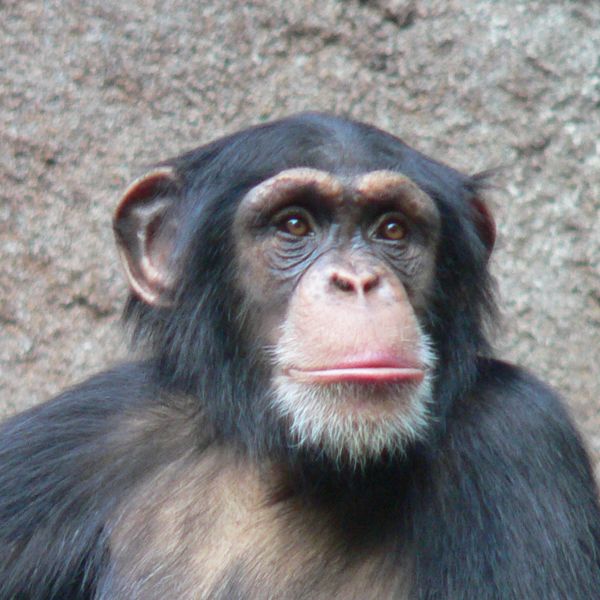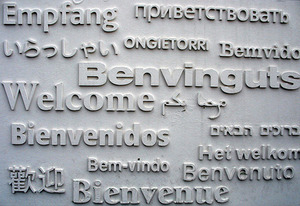The Science of Linguistics
Language, with all its complexity and creativity, is one of the most obvious ways in which humans differ from other animals.  Even after the most determined effort to teach American sign language to a chimpanzee (the late, great and much-discussed Washoe; d. 30 October 2007), the outcome was only vaguely successful (Washoe was found to reliably use only 250 signs, but in oddly formulaic ways). Chimps are our closest relatives in the animal world and share between 98 and 99% of their DNA with us. So if they can't use language, who can? Yes, birds, whales and many other species communicate in some very fascinating and harmonious ways, but that's very different from the complex linguistic system which has evolved in mankind, with its dozens of sounds which combine to make thousands of words with so many (fluctuating) meanings.
Even after the most determined effort to teach American sign language to a chimpanzee (the late, great and much-discussed Washoe; d. 30 October 2007), the outcome was only vaguely successful (Washoe was found to reliably use only 250 signs, but in oddly formulaic ways). Chimps are our closest relatives in the animal world and share between 98 and 99% of their DNA with us. So if they can't use language, who can? Yes, birds, whales and many other species communicate in some very fascinating and harmonious ways, but that's very different from the complex linguistic system which has evolved in mankind, with its dozens of sounds which combine to make thousands of words with so many (fluctuating) meanings.
Linguistics - the study of language - is therefore a varied and challenging field. Its practitioners, Linguists, take a different approach than the other kind of 'linguist' - the lucky ones with an aptitude for learning languages. Subspecialties within Linguistics include the study of sound (phonology), the study of sentences (syntax) and the study of meaning (semantics). These are the foundations of language study. Other specialisms branch off from, or overlap with them, but an understanding of these areas is essential for further study in the field. Witness their ubiquity in the first-year Linguistics syllabus at universities the world over. Add to this a look at processes of word formation (morphology), social aspects of language (sociolinguistics) and a review of language change since time immemorial (historical linguistics), and that pretty much accounts for the first year of most Linguistics degrees.
More advanced study can include 'semantics in action' - the way that meaning alters according to context (pragmatics), the way that texts are put together with multiple sentences (discourse analysis), and the way that writers use language to achieve particular effects (stylistics). typology, or comparative linguistics, (researching and comparing the syntax, semantics, phonology and morphology of various languages) is a rewarding albeit daunting task, but also one of great urgency given that half of the world's 6000 or so languages are said to be endangered.
Phonology takes a somewhat idealised view of how sounds relate to meaning. Much of the fine detail is filtered out to allow a clearer view. But of course, this fine detail does not go away! Instead it is the feature of a more precise examination of sound: phonetics. This covers all that goes into the communication act, from articulation by the speaker to the acoustics (how sound travels) to the listener's process of speech perception. Alongside the study of individual speech sounds, there is prosody: the study of the way sounds go together to form patterns of intonation and rhythm.
In recent years, linguistics has become much more 'applied', or experimental, in its approach. This has allowed for observation of and theory about how infants learn their first language(s), and how older children and adults may learn a second language.  This field is known as language acquisition. The outcomes of this area feed into methods of language teaching and testing for schoolchildren and adult learners. Also there is a related subfield, that may be labelled language pathology, which is concerned with the ways in which language acquisition can go wrong. This in turn informs the treatment of such disorders by speech language therapists.
This field is known as language acquisition. The outcomes of this area feed into methods of language teaching and testing for schoolchildren and adult learners. Also there is a related subfield, that may be labelled language pathology, which is concerned with the ways in which language acquisition can go wrong. This in turn informs the treatment of such disorders by speech language therapists.
Linguistics has also learned to borrow from other subjects, so that we now have the psychology of language (psycholinguistics) which attempts to model how language works in the mind, the neuroscience of language (neurolinguistics) which attempts to pinpoint how language 'lights up' in the brain, and the computer science of language (computational linguistics) which includes everything from statistics to speech recognition to machine translation. In addition, the power of the computer has allowed for the collation of massive databases of real (written and spoken) language, which can then be analysed for patterns of actual language use. One result of this development has been new editions of dictionaries, based on the patterns found in the databases. Which brings us onto yet more subject streams: dictionary makers are professional lexicographers who research the meaning of words (lexis) and how those words have developed over time (etymology).
And if that's not enough for you, you can always have a go at the Big Question: how did language evolve? This, another growing field, is known (unsurprisingly!) as evolutionary linguistics and asks: how, why and when did humans develop language (and why not other species)? Which brings us back full circle to Washoe the chimp. Phew! There you go. linguistics in a rather large nutshell.
Further reading
- David Crystal (2007), How language works: how babies babble, words change meaning and languages live or die, Penguin.
- Guy Deutscher (2006), The unfolding of language: the evolution of mankind's greatest invention, Arrow Books.
- Peter Matthews (2003), Linguistics: a very short introduction, Oxford University Press.
- Steven Pinker (2007), The stuff of thought: language as a window into human nature, Allen Lane.
- Michael Tomasello (2003). Constructing a language: a usage-based theory of language acquisition. Harvard University Press.





Comments
Add a comment